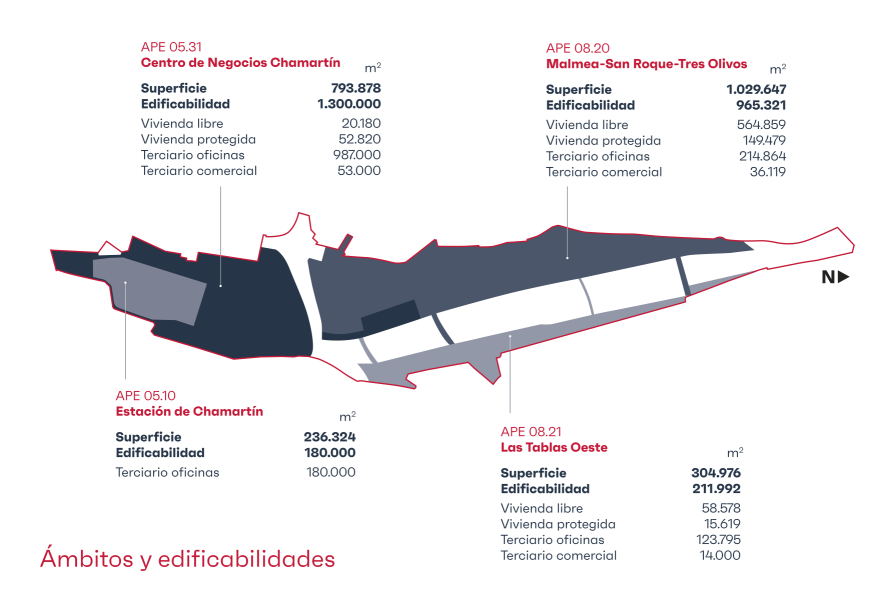24 March 2023
for Almudena Mansilla

The APE 05.31 Business Centre District is one of the four project areas that make up Madrid Nuevo Norte, with a surface area of almost 800,000 m2 and a buildable GFA of 1.3 million m2, and it stretches from Calle Mateo Inurria to the M-30 highway and surrounds the Chamartín-Clara Campoamor Station, which will serve as a mobility hub.
The future business district of Madrid will be built in this area, with nearly one million square metres of office space, 2,595 new homes and a large central park covering the railway tracks, a new iconic public space, which will become the green heart of the business centre.
The Madrid Nuevo Norte CBD will create a new skyline in the capital, thanks to the 30 new office buildings that will be erected in the area, eight of which will be more than 30 storeys high, including a tower of up to 70 storeys that will be the tallest building in Spain, with a height of more than 300 metres.
As the president of the APE 05.31 Management Committee, Belén Piserra, explained that: ‘Most of this area is zoned for commercial use, with a buildable area of 987,000 m2 for offices, with the aim of providing the city with the most modern, flexible and efficient workspaces, designed to meet the current needs of companies and ready to adapt to the challenges of the future’.
With regard to the timeframes, Piserra pointed out that the intention ‘is to be able to unveil the initiative for completing the planning of the area during the course of this year, which, once approved by the City Council, will allow us to set up the Owner’s Association and start the development work as soon as possible’.

One of the most distinguishing aspects of this business centre, in contrast to business centres in other cities with only offices and no life when the working day is over, is the key role that housing, and more specifically affordable housing, will play in the area.
A total of 2,595 dwellings are slated for this business district, more than 20% of which will have some form of public protection (houses with publicly protected basic prices [VPPB] and houses with publicly protected limited prices [VPPL]), which is double what is required under the Spanish Land Act [Ley del Suelo] for new developments on urban land.
‘But, in addition to subsidised housing,’ said Piserra, ‘the planning has established that the assignments of lucrative use to be received by the Madrid City Council will be given entirely for residential use, so that the Council will have an additional 1,600 available free market housing units that it can use for different housing programmes’.
Therefore, in total, the City Council will own 62% of all the housing to be built in the Chamartín Business Centre, ‘which, without a doubt, is something absolutely unique in this type of development’, said Piserra.
The Chamartín CBD includes the construction of strategic infrastructures for the city and the region.
The most striking is undoubtedly the covering of 150,000 m2 of railway tracks: one of the most ambitious engineering works of this type at the international level, which will make it possible to create a 14.5-hectare Central Park. Covering these tracks will require building 1,800 concrete piles, 74 of which have already been built on the rail yard in the southern area of the station.
Next to Chamartín-Clara Campoamor station, a large 33,000-m2 multimodal interchange will be built, with access to all local and regional modes of transport and with the capacity to serve more than 105,000 passengers a day.
The new Metro line that will run through Madrid Nuevo Norte will depart from this interchange. The first of the three new stations on this line will be in the heart of the Business Centre, in the extension of Calle Agustín de Foxá, and will create a powerful interchange system with the existing Begoña station and the future intermodal area of La Paz.
Another of the key infrastructures will be Agustín de Foxá Street, the main axis of Madrid Nuevo Norte, which, in the Business Centre area, will have an underground level to allow intercity bus access to the interchange, the transit of services associated with the Business Centre, goods and courier services, and access to the underground car parks. This will free most of the road traffic from the surface level of the street, leaving the surface level for low-speed traffic, city buses, bicycles and pedestrians.
Lastly, the major infrastructures will also include the new urban connections to the north, as Madrid Nuevo Norte will not only close the gap between east and west, but will also build two new bridges to link north and south over the M-30 ring road: One, extending Calle Agustín de Foxá, and the other, as an extension of Avenida de Burgos to connect it with Calle Antonio de Cabezón. The current Mauricio Legendre bridge will also be upgraded and widened to provide it with green areas that will give continuity to the environmental axis that will run through the whole of Madrid Nuevo Norte.